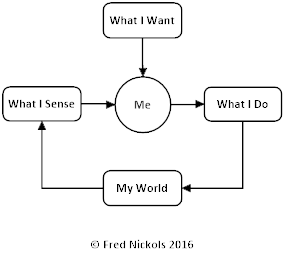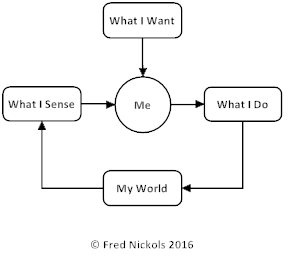[From Fred Nickols (2016.09.22.1209 ET)]
Hi, Chad.
Yes, Iâm on both lists but far more active here than on EvalTalk.
FWIW, the HPCT diagram to which you refer is simply my attempt to depict current thinking in PCT circles; itâs hardly âmine.â? That said, were I to add a 12th level, which I might do for my own purposes, it would probably be âSelf-Conceptâ? or perhaps simply âSelf.â? Iâd have to go back and see what Bill Powers had to say about the self or what I think he referred from time to time as âthe observer.â? In my case, the observer is me.
I am not a die-hard PCT fanatic and certainly not a PCT expert. Iâm an old weapons systems technician who is familiar with gunfire control systems and other kinds of control systems and I see the links to human behavior and a view of people as âliving control systems.â? However, for my own purposes, I prefer a much simplified view of all that (see below):

In this scheme of things there is What I Sense, What I Want, My Actions and My World. At the center of it all is me; I have to make sense out of it all and I have to act accordingly. Generally speaking, Iâm acting to keep things the way I want them. For much of it (walking, breathing, heart beating, etc.,) I donât have to do much thinking; I have built-in control systems that make those things possible and effective. For other things (e.g., writing a column, managing a project, counseling a client) I have to give the matter some thought; I have to be much more deliberate. Here is where, for me, the higher levels of hierarchy come into play. What also comes into play are my perceptions of the way my world is structured, organized and the way it works. I have to be concerned with proximate, intermediate and ultimate variables in the world out there. I have to employ something like a domino theory of results. I have to be concerned with solutions paths, with how to affect something over here right away that will eventually affect something over there later on. I must be concerned with interventions, not simply actions. In my world out there are other actors and factors that might want certain things to be other than the way I want them. There is the potential for conflict. There are also simple obstacles and barriers that I might have to overcome, what we know in PCT as âdisturbancesâ? (including those posed by competitive or conflicting forces). At the center of all this is Me. Iâm the one who has to make sense out of all this and act accordingly.
I was also trained as an internal organization development (OD) specialist so I am familiar not just with closed-loop control systems a la servomechanisms, etc., but also those fabled open systems we know as organizations. So I know a bit about hard systems and soft systems. Per your comments about the confusion of terminology (and concepts) when it comes to systems, I agree. I know some IT folks who are whizzes at building computer systems but donât have a clue when it comes to looking at or understanding people or organizations as systems. There is a real mish-mash of concepts, theories and models of systems, systems thinking, etc., etc. I know one fellow who has struggled for 50 years to get people to make a distinction between âsystemâ? and âsystemsâ? and I donât mean simply singular and plural. He does battle still.
Per your comment about dynamic relation vs persistent object, I think most people view a system as a collection of objects having certain relationships to one another. I can use that view when appropriate but itâs not how I view systems such as people and organizations. There, I hark back to the notion of people and organizations as open systems, as an ongoing cycle of recurring events, marked by the acquisition of inputs, some of which are transformed into outputs and some of which serve to nourish and sustain the system, and the exchange of some of those outputs for new inputs to continue the cycle.
In the end, Chad, we are stuck with having to do what the great thinkers have all said from time to time: âFirst, define your terms.â? That goes for system, systems, organizations, people, behavior, perceptions, actions and just about anything else of interest. As for âlanguaging,â? I have long maintained that âLanguage shapes thought and thought shapes behaviorâ? so weâre probably on common ground there. Then again . . . who knows?
Regards,
Fred Nickols, Knowledge Worker
My Objective is to Help You Achieve Yours
âAssistance at a Distanceâ?SM
image0014.emz (4.43 KB)
···
From: Chad T. Green [mailto:Chad.Green@lcps.org]
Sent: Thursday, September 22, 2016 11:53 AM
To: csgnet@lists.illinois.edu
Subject: RE: PCT robotics paper
[Chad Green (2016.09.22.1153 EST)]
Fred, youâre also a participant on the EVALTALK listserv. A little over a week ago you posted this: âMy favorite tagline is âBe sure you measure what you want. Be sure you want what you measure.ââ?
Did you notice Bob Williamsâ reply to my post on Sept. 7 (Re: Complexity) concerning the implications of the paradigm wars in the systems science community? Toward the end he wrote:
âBecause the management field failed to keep track of the important developments in the systems field in the 1970âs and 1980âs we now have a confusion of terminology. So for instance, nobody I know in the systems field talks about âat the systems levelâ when talking about very large management processes. That comes straight out of the management field, but creates enormous problems for evaluators who believe that âsystemsâ is solely about âbig stuffâ.â?
Now take a look at your levels of HPCT example here: http://www.nickols.us/LevelsofHPCT.pdf . Doesnât level 11 also appear to reflect this outdated âat the systems levelâ? construct to which Williams was referring? In other words, has PCT also failed to keep track of the significant developments in the systems field?
Maturanaâs notion of the self as a dynamic relation rather than a persistent object may be a good replacement candidate for HPCTâs Level 11. Hereâs a relevant passage from Maturanaâs (1995) excellent paper Biology of Self-consciousness:
“As the self arises as an experience in the experience of self-consciousness, self-consciousness and self take place as dynamic relations in the flow of languaging, and cannot be talked about without living them as experiences in the flow of language. The result of this situation is that all explanatory propositions that do not propose to treat the self as an entity (that can be ‘experienced’) seem off the mark. Strictly, however, that is not the problem for the explanation, which as a generative mechanism only proposes a process that if it were to take place would give as a result the experience to be explained, and does not replace the explained experience as an experience. But that the explanation should show that the self, self-consciousness and consciousness are but relational dynamics in the flow of our living as human beings, seems difficult to accept because we exist for ourselves as entities.”
Source: http://www.univie.ac.at/constructivism/archive/fulltexts/639.html
Best,
Chad
Chad T. Green, PMP
Research Office
Loudoun County Public Schools
21000 Education Court
Ashburn, VA 20148
Voice: 571-252-1486
Fax: 571-252-1575
âWe are not what we know but what we are willing to learn.â? - Mary Catherine Bateson
From: Fred Nickols [mailto:fred@nickols.us]
Sent: Wednesday, September 21, 2016 5:53 PM
To: csgnet@lists.illinois.edu
Subject: Re: PCT robotics paper
[From Fred Nickols (2016.09.21.1752 ET)]
Yea! Congratulations, Rupert. Hard won and well deserved!
Fred Nickols, CPT
Writer & Consultant
“Assistance at a Distance”
Sent from my iPad
On Sep 21, 2016, at 5:41 PM, Rupert Young rupert@perceptualrobots.com wrote:
[From Rupert Young (2016.09.21 22.40)]
“A General Architecture for Robotics Systems: A Perception-based Approach to Arti
ficial Life”
I am pleased to say that my paper has been accepted for publication in the Arti
ficial Life journal. It is basically applying the PCT architecture to robotics, but also positioning perceptual control as the missing ‘stuff’ of AI/AL (see attached).
It’s a fairly long paper at 48 (book) pages (72 with refs and appendices) with a fair bit of background of putting PCT into the context of AI/AL, and a basic robotic experimental system.
Arti
ficial Life is a major journal in the field so it will be interesting to see the exposure and feedback it receives. However, there’ll be a bit of a wait. I was going to annouce this soon, when they sent out the contents for the Winter edition, but, for some reason, it has now been bumped to the Summer edition next year. So, I thought I’d let you know now, and I’ll send an update nearer the time, along with pre-publication copies.It’s been a long road; by the time the paper is published it would have been over three years since first submitted, but at least it has now been accepted.
Regards,
Rupert
<nature.pdf>
